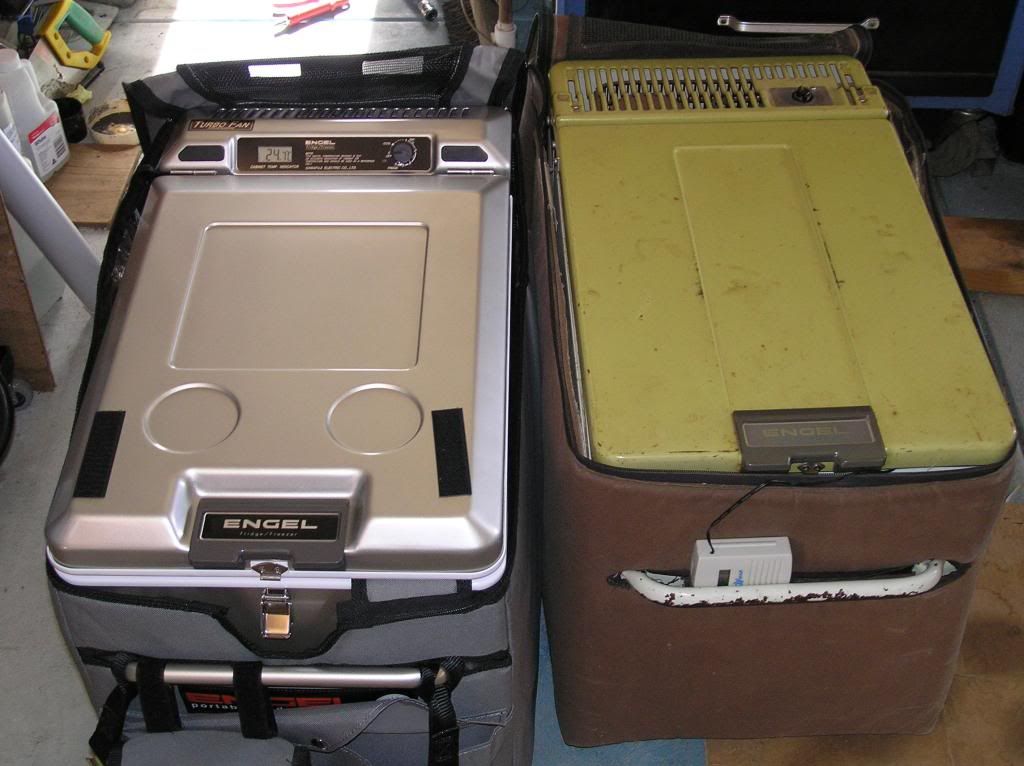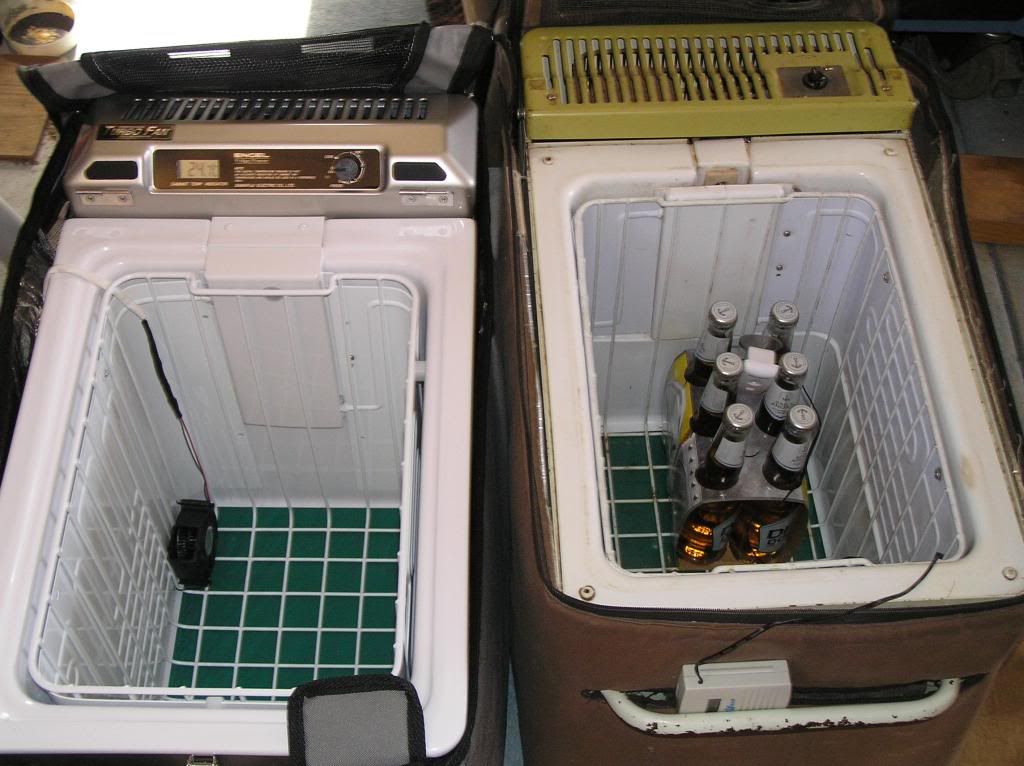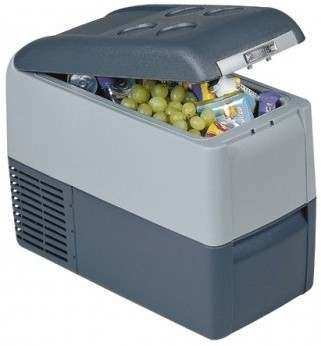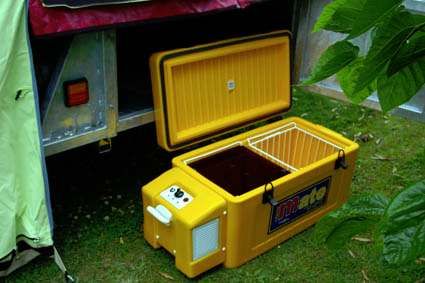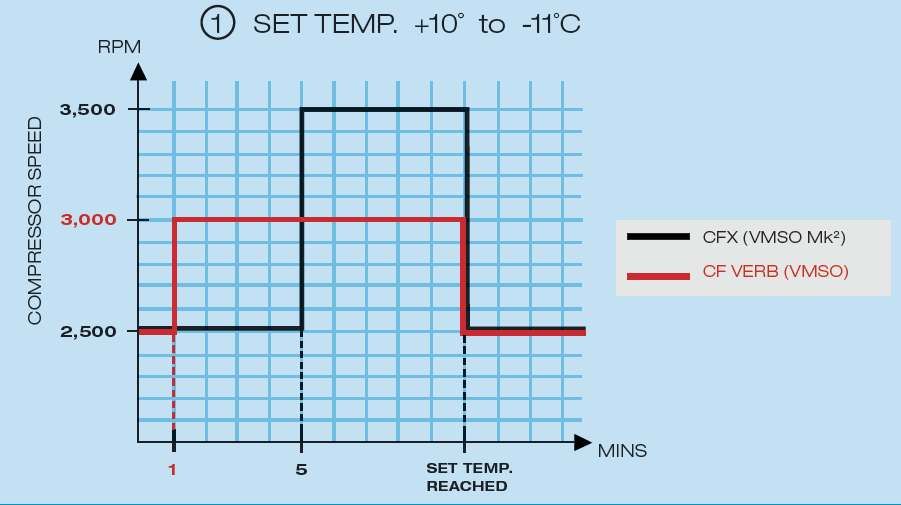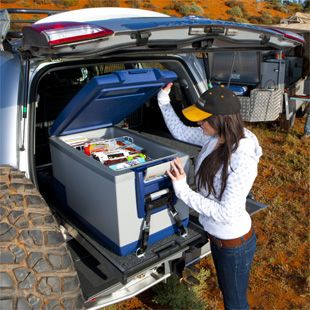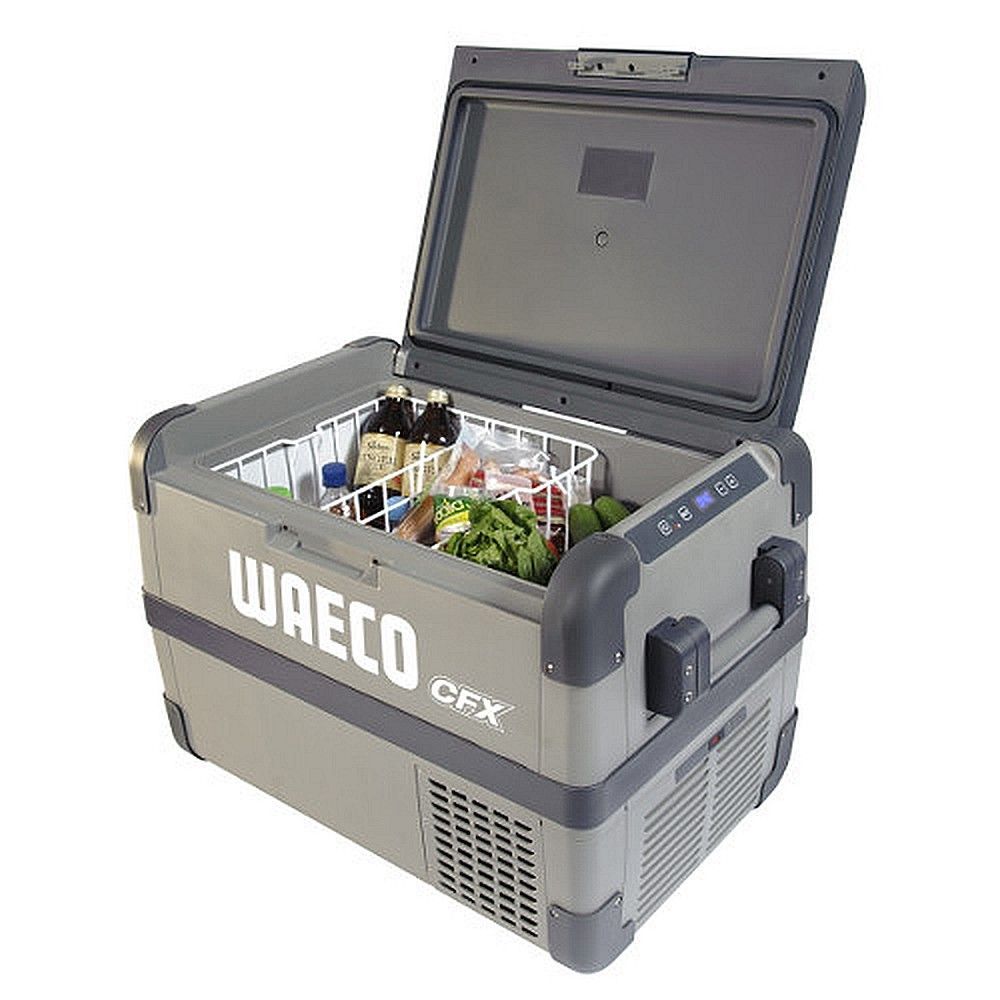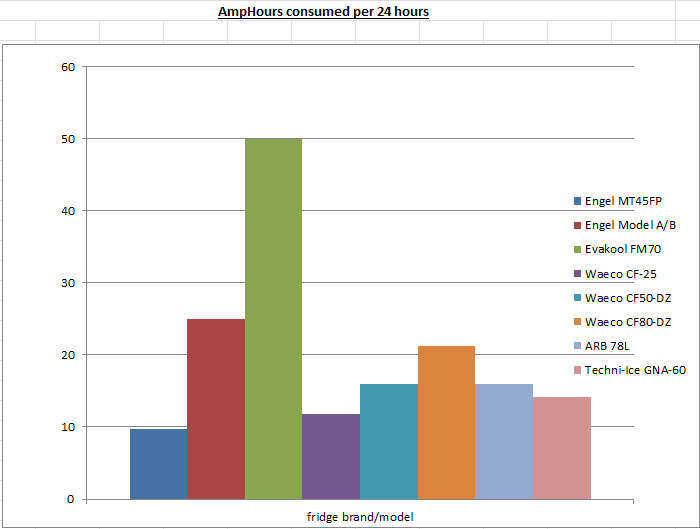(Edit: March 2014 -What started out as a test of an old and new Engel in regards to power consumption has now slowly developed into a test of consumption of many different fridges and sizes. I note that when researching to purchase a mobile fridge, there are many things to consider. Most of these things are pretty straight forward (size, layout etc). But power consumption is certainly is not straight forward. Non standard units and misleading advertising for example - What draws more power, something that draws 5 amps max or something that uses an average 1.8A/hour ??? Without taking power consumption measurements and/or knowing compressor cycle times, the previous two statements mean little. However the later statement at least has a time based component to it and from that an AmpHour unit per day can be calculated. It is my experience the greater majority of potential customers wouldn't have a clue how to do this nor what it means. This is where this blog post comes in. If you are in the market for a new fridge, and power consumption is a contributing factor of your decision making process (as for most of us it is) then I hope you gain something constructive from the results below. This will be an evolving document so check in every now and then. But again, I will reiterate:- this is a test performed in at best a constant ambient temp I can achieve with a standard datum of cold loading of a 6 pack. This test makes no assumptions as to how consumption will change between different fridges with regard to changing ambient's , cold loading and lid opening sequences. So take the results as they are. Cheers.....)
I recently acquired a new generation Engel. One big reason I purchased this was that I had heard their efficiency is very impressive these days. As such, I thought it was worthy to do a bit of a comparo and see how the product has changed over the years.
First up a 2012 MT45FP
and a Model A/B 40L circa early 1980 vintage.
A couple of features I noticed the new has over the old,
- evaporator plate goes all the way to the floor, unlike the older which only goes 1/2 way to the floor
- Auto switching power inputs. Always defaults to ac input when available.
- Led interior light, a bit of a token measure, but better than none I suppose
- and a cabinet temp gauge
Physical size is about same, metal work is similar but more modern, a far better lid latch and lid hinge mechanism over the older model.
Now for the important details: how do they compare in performance.
The test: All fridges Pre chilled, lightly loaded with a cold 6 pack, kept to approximately 3-5degrees measured with 2 temp probes and run of a wet cell battery for 24 hours to monitor power consumption.
The MT45FP
First up, the cabinet temp gauge was within a degree of the two probes all times I looked, so that's a nice feature, an accurate inbuilt gauge. I do not know the detail on the position where the sensor monitors from.
Over 24 hours the following was noted:
Ah used 11.5
Av running amps 2.6
max amps 3.5
Model A/B
Ah used 26.5
Av running amps 4.8
max amps 5.2
That to me was extremely impressive. The new unit consumes nearly 2.5 times less power than the old.
To add some comparative figures to this, I also have 2 Danfoss powered fridges, both less than 12 months old.
The Waeco CF25 used 13Ah (test result obtained at the same time as above), the Evakool FM70 uses a whopping 50 odd (values obtained from former testing I performed). Admittedly, they are all different sizes, therefore efficiency would and should differ as you would expect due to the large differences in surface area of each unit absorbing heat from its surroundings and the volume of cabinet itself.
Now a fairer comparison would be to test a similar sized 40 odd litre Danfoss unit. Unfortunately, I don't have one of these on hand, so you can draw your own conclusions if you think this comparison is worthy of inclusion or not. You could also argue the test environment, a relatively uniform place in regards to ambient temps is not considered a real world test. At a camp site or in the back of a car, this probably wouldn't happen.
But I suggest, testing in the real world of changing ambient's, is more about testing the fridges insulation performance. I admit this is also very important when deciding upon what fridge to purchase. But as I don't have a controlled environment nor the capacity to test all 3 fridges in the same field at the same time, that is a mute point. The comparison is more about measuring the Fujisawa v's the Danfoss power efficiency. You can modify a fridges thermal insulation relatively easy, add a thermal bag for example. You cant do much with the compressors efficiency. And on that point alone, I believe the above comparison is valid and worthy of mention.
I feel that the results I posted on the 1/2 sized Waeco CF25 using 18% more power than the new MT45, compressor efficiency is going to go in Engel's favour by a fair way in a similar sized unit as I would expect a similar sized 40L Danfoss fridge to be much greater in consumption then the CF25. I'm happy to be proven wrong. In fact, these results contradict a recent 4WD Action fridge test of which the pdf can be downloaded here:
Click to download PDF: 4WD Action comparo
In that, the Danfoss units performed marginally better in consumption than the Engel. But they did testing in a controlled environment of ramping ambients up and down. 25>0>25 and another from 25>60>25. I feel the 25 degree to 60 degree and back again ramp test to be at the very extreme of what most people would experience.
But in summing up, and I don't want to start an Engel v's the others type of debate, if power efficiency is your goal (as it is for most of us), I just cant see how your next fridge wouldn't be an Engel from the results I posted.
Post Script:
Thinking about the above test, I am going to perform the same test but the power source will be a uniform mains fed dc supply. That way I can discount changes in amperage and voltage as the battery state of charge changes. I will add these new test results below as they come to hand.
Well the results of this are now in. Very similar in differences to just being run on battery alone. And I've added better temp monitoring results than the first test (which I didn't record)
MT45:
Internal temp/Ambient (min): 1.6/18.5
Internal temp/Ambient (max): 2.7/21.6
Amps (peak): 4.4
Average running Amps: 2.6
Ah consumed (24 Hrs): 9.7
Model A/B:
Internal temp/Ambient (Min): 1.8/20.4
Internal temp/Ambient (Max): 2.3/22.3
Amps (peak): 5.25
Average running Amps: 4.7
Ah consumed (24 Hrs): 25
*****************************************************************************************************************************************
And now a few others for comparison:
Waeco CF25:
set at 2 degrees on the panel:
Internal temp/Ambient (Min): 0.6/20.7
Internal temp/Ambient (Max): 3.5/21.7
Amps (peak): 6.58
Average running Amps: 4.1
Ah consumed (24 Hrs): 11.8
*****************************************************************************************************************************************
Evakool FM70:
Internal temp/Ambient (Min): TBA
Internal temp/Ambient (Max): TBA
Amps (peak): TBA
Average running Amps: TBA
Ah consumed (24 Hrs): 50Ah
*****************************************************************************************************************************************
EDIT: Jan 2013
Waeco CF50-DZ:
So I got hold of a Waeco CF50DZ to test. Same BD35 compressor as the CF-25 and the Evakool FM70 I tested previously.
So I expected the result to lie somewhere in between these. I assume the difference in consumption between the fm70 (50Ah) and the cf25 (12Ah) due to the volume differences between the two. I estimated the CF50 to consume around the 30 mark.
Just to refresh the test performed. A pre chilled fridge, with a 6 pack inside with internal temperature set to 5degrees, unopened for 24 hours. I didn't have access to my max/min thermometer, so temps stated are average.
So the results for the CF50DZ (divider removed):
Average Internal temp: 5degrees (set at 2 degrees on the control panel)
Average Ambient Temp: 26 Degrees
Max Amperage drawn: 5.9A
Average running amps: 3.0A
Power Consumption: 16Ah.
That is very good and about 1/2 the power used than I expected. But now it only leaves me more question's to ponder.
I watched the amperage quite a few times when it cycled on. It starts by drawing about 4 amps, then quickly recedes down to 3Amps. Never did I see it draw more than 4A. But my meter logged a 5.9A peak. I wonder when and for how long this occurred?
It's the same compressor as the CF25 and the FM70. Both these run at near 5Amps. They would never run at 3 amps. Why does the CF50 draw so little? I think VMSO is the answer. More on that in the CF80-DZ test below.
I can understand the difference of 12Ah of the CF25 to the 16Ah of the cf50dz as it's twice the volume. I think the efficiency of the CF50 is great in comparison.
However, my main concern now is why does the FM70 draw 3 times the power of the CF50. Its volume is only about 50% greater again than the CF50.
*****************************************************************************************************************************************
EDIT: March 2014
Waeco CF80-DZ:
I have now added a Waeco CF80-DZ to the mix. I was very interested in this one to compare to the FM70 as they are both BD35F compressors and similar litreage.
Just to refresh the test performed. A pre chilled fridge, with a 6 pack inside with internal temperature set to 5degrees, unopened for 24 hours and dividers removed.The 6 pack was placed in the centre of the fridge compartment.
I note that I had to set the panel to 0 degrees to obtain the 5 degree content I was seeking. Most other units tested achieved this at the 2 degree setting.I guess this is due to the fact that the evaporator plate is in the freezer side and relying on thermal transfer between compartments?
I have added another test for future edits. The measuring of the case temperature (inside of any insulated bag if fitted). This will be done with a non-contact IR thermometer to find its coolest temperature. I will then relate this as a value minus current ambient. That should then give some idea as to how the insulation properties differ.
Now, onto the CF80-DZ results:
set at 2 degrees on the panel:
Internal temp max: 5.1
Internal temp min: 4.5
Ambient Temp max: 25.3
Ambient Temp min: 20.6
Amps peak: 7.01
Amps running average: 3.6
Power Consumption: 21.2
Case temp: 5 degrees below ambient
Cycle times: I noted cycle on/off times periodically. You can almost set your watch by it. That was a bit spooky. 8 Minutes of run time with a rest period of 16 minutes.
VMSO: I have to say, from the two fridges tested thus far with VMSO (CF50 + CF80) , I am a big fan. I love the way it runs and changes speed/draw and start up current dependant upon condition. Whilst it maybe a little early to tell, I suspect this is having a big impact on the compressors overall efficiency.
My research to date tells me this VMSO is a Waeco propriety product. I note there is reference in Danfoss manuals of a similar type of controller (101N0300) - AEO (Adaptive Energy Optimisation). Its description of function is exactly what I have observed occurring with the VMSO units.
As Quoted......... "In AEO (Adaptive Energy Optimizing) speed
mode the BD compressor will always adapt its speed to the actual cooling demand."
As my FM70 consumes 50Ah in the same conditions as the CF80 (2.5 times the power), I would love to get a hold of this 101N0300 controller and retro fit it to see what that could do for my excessive consumption. However, I suspect this will not be a cheap exercise.
I also note Waeco has introduced a MkII version of VMSO. This is currently fitted to the new CFX range. On that, I note this new range has now gone away from Danfoss (now made Secop due to a business takeover) and have fitted their own "Waeco" compressor. No doubt an Asian manufactured copy of the BD35F. It seems their foray into cheaper compressors (for example the now non used Wanbao) is in a state of constant evolution. It will take some considerable time for this new "Waeco branded" compressor to prove itself such as the Danfoss unit has over many years. And on that, I say the jury is out on any of their product with this new compressor fitted.
Freezer results: So seeing as this fridge is similar in size to my FM70, I decided a comparison as fridge/freezer test had also to be performed.
In the same conditions, the FM70 consumed 56Ah.
The CF80-DZ:
Set at - 9 degrees (as this is what the owner uses)
Internal temp max: 7.6/-9.7 (being fridge contents/freezer contents)
Internal temp min: 6.8/-9.7
Ambient Temp max: 24.8
Ambient Temp min: 20.6
Amps peak: 6.25
Amps running average: 3.6
Power Consumption: 26.6
Case temp: 5 degrees below ambient
So, compared to the FM70.....an impressive result in my opinion. So much so, I may even look into replacing the FM70.
To finish up this CF80-DZ test, I need to make a couple of comments.
The fan on this is noisy. Same as my FM70. If you sleep near it, it may drive you nuts. In my situation though, I have come to ignore this background noise.
I also think like I had to do with the FM70, the dividers need a bit of playing around with as the fridge temps jumped up to a higher level than I would prefer. A larger gap under the divider should bring those temps down closer to the recommended 5 degrees without sacrificing freezer temperatures. I also note that whilst I had to set the unit at 0 degree's for a fridge only content of 5 degree's, the unit all but matched the freezer content when in fridge freezer mode.
*****************************************************************************************************************************************
2nd EDIT: March 2014
ARB 78L:
I have also got hold of an ARB 78L to test. This is invaluable as it is performed back to back with the CF80.
Things to note. This unit feels like it is built like a "brick shithouse". The metal sides and intergrated plastic feels so much heavier duty than any of the other fridges I've tested to date. Lid included. Mind you part of my testing isn't to bash the sided in with a brick......But I can tell you, the casing and lid appear to be far superior than any other I've had my hands on.
It has also been designed from the ground up by with someone with some knowledge on what is required for a travelling fridge in this country. The internals are neatly sized for correct can spacing, the lid hinge is bullet proof, the lid locking mechanism isn't a cheap afterthought and the tie down handles do not protrude the casing (A big advantage on a big fridge where space constraints become an even bigger burden). What more can I say, on face value this oozes quality. But it's the test results I'm more interested in. So here we go:
Set at 2 degrees on the panel:
Internal temp max: 5.0
Internal temp min: 4.4
Ambient Temp max: 26.5
Ambient Temp min: 23.6
Amps peak: 8.4
Amps running average: 4.3
Power Consumption: 15.9
Case temp: 4 degrees below ambient
Some interesting results in there. The weird one is the Peak draw of 8.4Amps. I tested this 3 days in a row, resetting the meter each time and the same peak was measured. That is by far the largest peak I have ever seen.
Also I have to ask....does it ever run? I struggled to get cycle times on this unit cause it barely ever ran. Is that due to the heaviness of the case and its insulation???? noting it was a full one degree better in the case temperature test over the CF80. What cycle times I did gather was it powered on for 8 minutes but rested for 45 odd minutes. So it did about one cycle per hour compared to 3 for the CF80.
And I think that is shown in the power consumption stakes. 15.9Ah for the 24 hour period. Size for size, one of the most efficient I've tested to date. About 25% better than the similar sized CF80. Or about equal to the CF50-DZ.
Top effort there. But for me personally, the functionality of a dual zone would mean I have to take a power hit. If a DZ isn't on your bucket list and you are researching a large fridge, you would have to give the ARB 78L very serious consideration.
*****************************************************************************************************************************************
3rd EDIT: March 2014
Techni-ice GNA-60:
Its all go this month. I have now got a hold of a Techni-Ice GNA60. This will be a very intriguing test for me as we now move away from Fulisawa and Danfoss. Techni-Ice are renowned for their ice boxes and freezer packs. Will this spill over to their fridge range?
This unit is powered by the Italian Domus compressor. What alarms me before the test is the specs show an average comsumption of 1.5 A/hour or in equal terms 36Ah in a 24 hour period. That seems quite high, however lets let the test results speak for themselves.
Set at 7 degrees on the panel:
Internal temp max: 4.9
Internal temp min: 4.1
Ambient Temp max: 26.2
Ambient Temp min: 22.7
Amps peak: 9.7
Amps running average: 3.0
Power Consumption: 14.2
Case temp: 5 degrees below ambient
So to make some comments here.......It used half the power it was specified as using. But those figures are at 32 deg's ambient with a content of -2 to +2 degrees. I think the 14.2 achieved was a good result considering its size. I would take the CF50-DZ as its direct comparison (but bear in mind the DZ's evaporator plate is only in the freezer side, so there would have to be some loss there due to thermal transfer). One strange thing over the others is the fact I had to set the temperature higher than was actually recorded. All others have been the reverse.
I like the fact it has a full, flush stainless evaporator plate. No chance of rubbing holes through refrigerant gas tubes. The Domus compressor must be the quiestest of any unit I've ever ran. Infact it was so quiet, I never really got the chance to measure compressor cycle/rest times. I also note, this is equiped with a controller that varies compressor speed acording to demand, just like Waeco's VMSO. At start up you could watch the amps slowly fall away, but then at times throughout the cycle, you could hear the motor wind up and watch the amps rise correspondingly. So a nice neat feature to have. I cant see any mention of this on their site. it also had the highest measured peak Amps of any I've tested. Why, I do not know, the few startups I witnessed were in the 5 amp range.
I note from the manufacturers literature that it also has a delayed start. One you turn it on, it may take 5 minutes to fire the compressor into action. I wonder why this is???? One thing I dont like about it though is the main on/off switch being a toggle down by the power cord inlet. If something was to roll around or move whilst the fridge is in the rear of the car, and it bumped this toggle, you could end up with a fridge that was inadvertantly turned off.
But overall, a very good result. The fact that this is the cheapest off all the units I've tested above (by a long margin in some instances), you would have to give a unit like this due consideration.
*****************************************************************************************************************************************
EDIT: March 2015
Waeco CFX50:
Coming soon.
Boasting a host of new features, including Waeco's all new home grown compressor (no doubt a clone of the Danfoss and made in china) and featuring a MKII variant of Waeco's VSMO. It will be very interesting to compare this with the CF50DZ and the Engel 40 I have data for. I'm hopeful of good results, cause I just purchased the fridge in this test on a hunch that it will be similar to the CF50DZ result, as I can find no data to back up my hunch. That said, I have been conversing with one who has tested his CFX60 along the same lines as my testing above. The results of that look very promising.
So enough jibber jabber, on to the testing results:
Preliminary results (I've only had it in my possession for a day)-
Set at 2 degrees on the panel:
Internal temp max: x
Internal temp min: 1.5
Ambient Temp max: 25.3
Ambient Temp min: 19.3
Amps peak: 4.1
Amps running average: 3.5
Power Consumption: 9.5 Ah
Case temp: x degrees below ambient
So I note that a 2 deg setting is keeping the content at that temperature. Next I will up the setting to 4 degs to try to keep content nearer the 5 degree target. I also note is low consumption. This is a good thing, however the ambient is a bit lower than in my other tests. So I will re do the test, set at 4 degrees and with the Engel40 side by side to show a comparative result in identical ambients.
Stay tuned.
*****************************************************************************************************************************************

